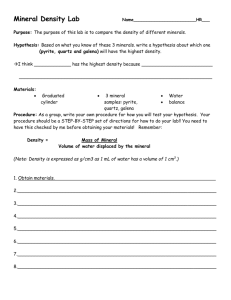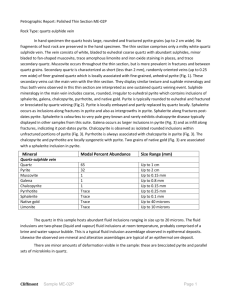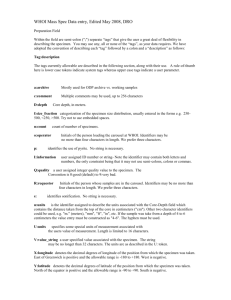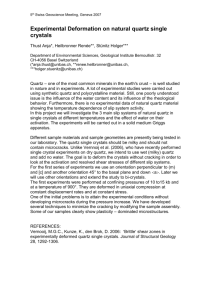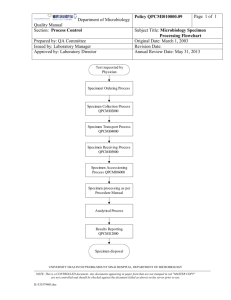4 6 UG 1922
advertisement
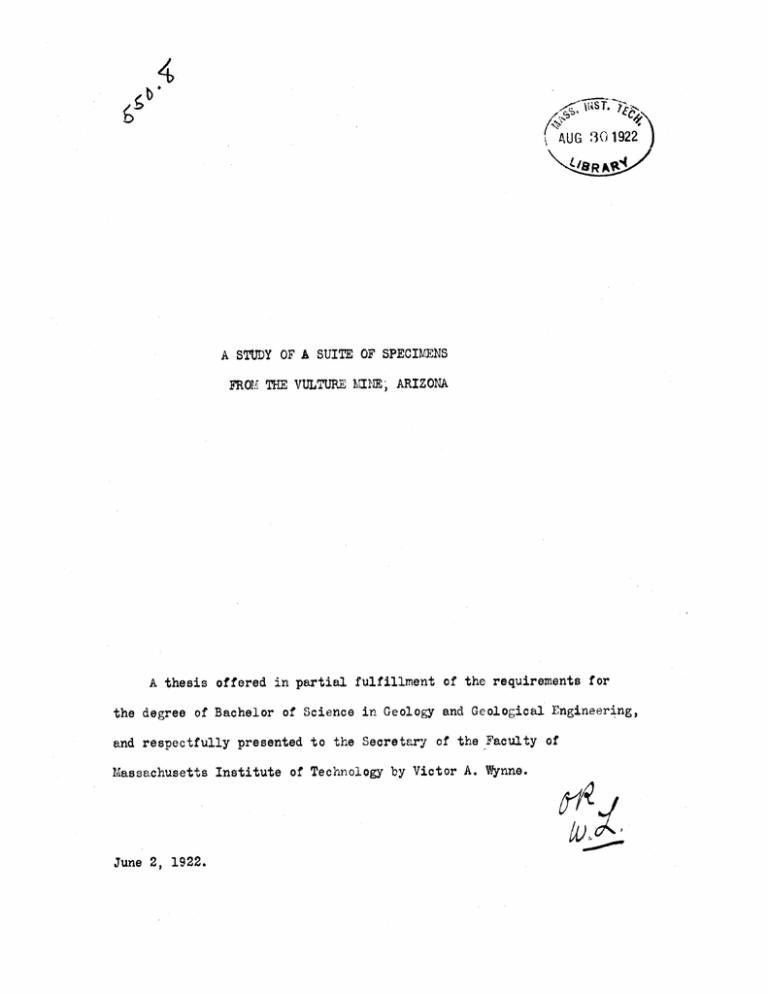
4 6 AUG 30 1922 /SR A A STUDY OF A SUITE OF SPECIMENS FROMT THE VULTURE INE, ARIZONA A thesis offered in partial fulfillment of the requirements for the degree of Bachelor of Science in Geology and Geological Engineering, and respectfully presented to the Secretary of the Faculty of Massachusetts Institute of Technology by Victor A. Wynne. June 2, 1922. The Vulture deposit lies in Maricopa county, in the desert General: region of Arizona, 14 miles from the town of Wickenburg. The deposit was first worked in 1866, and for several years yielded Then on account of litigation the annually about $30Q,000 in gold. mine was idle for many years. Reopened in 1908, the deposit yielded in the following year gold and a little silver, with a total value of The mine was closed again in 1917, and has remained so. $21,480. The outcrop of the lode is a butte of quartz, 450 feet long, and 250 feet across its base, which rises 80 feet above the level of the mesa. 85 feet in width of this is vein matter. The formations of the region seem to be metamorphosed Paleozoic sediments, mostly quartzites; but the Vulture lode is said to lie in a zone -of talc-slate 400 yards wide. "The body or bodies of gold quartz lie in about the middle of this belt, and strike and dip parallel to the stratification of the slates, which runs a little north of west, and dips north-northeast 45 degrees." At a depth of 232 feet below the mesa, the fussure changed its dip to vertical. The best ore was found just above this point. The ore was worked for its free gold; but the sulphides, averaging 1 1-2 %, assayed $350 per ton (1873). An undated memorandum gives the average value of the ore as y20.00, the ratio of concentration as 33 to 1, and the analysis of the concentrates as follows: CaO Gold 59 lbs., 6.50 oz. Insoluble 21.3 % Silver Lead 11.0 oz. 20.0 % Copper Iron 2.18 % 21.6 128e60 Object of the Thesis: The collection studied comprised fifteen specimens representing both ore and country rock. Of a number of the rock specimens thin sections were available, and were studied. In order to investigate the relation of the ore minerals several polished sections were made, and examined under the reflection microscope, microchemical tests for the identification of the minerals being used. The significant observations made will now be recorded. Afterwards a few conclusions as to the character of the deposit can be drawn. Specimen 242: "Country, west end 950' level (over)". The specimen has a purphyritic appearance. Large rounded crystals of quartz are embedded in a light-green matrix of kaolin, with sericite and chlorite. It probably represents a granite pornhyry which has undergone extreme alteration, none of the original feldspar or ferromagnesian minerals being preserved. Specimen 243: "Hanging wall rock 10'-15' from the ore shoot, 750' level". This rock, of light green color, and dense texture, appears to consist principally of grains of quartz, and of kaolin. Particles of pyrite ane disseminated through it, and occur more thickly embedded in fracture surfaces, upon which also calcite has been deposited in a thin layer. The pyrite has been oxidized in part upon these -4- fracture surfaces, probably to limonite. The rock seems to have been derived from a shaly sandstone by dynamic metamorphism, and to have been subjected later during the mineralization period of the vein, to the injection of the pyrite. The calcite is of late development. Soecimen 244: "Footwall, 850' level". The specimen is from rock of a pronouncedly schistose character, is very dense, and of dark-green color. The sahistose minerals appear to be both chlorite and sericite. Fine-grained quartz is distributed profusely through the specimen, but in particular thin sheets of it lie in planes determined by the schist structure. Examination of the thin section brings out several points of importance. An interesting feature is the presense of minute prismatic crystals of tourmaline, recognized in section by their bluish-green color and pleachroism, with their strongest absorption perpendicular to the principal zone. The sketch shows two small tourmaline crystals surrounded by a number of minute microlites of the same mineral. These microlites occur abundantly throughout the section. Sericite is abundant in small flakes, often in aggregates with flakes of chlorite. The schistosity is indicated by the parallel arrangement of long sections of muscovite or sericite plates. - 5 - The quartz seems to be of two periods of genesis, the earlier quartz being much altered to sericite, and the quartz introduced later being in relatively clear rounded grains. Of particular interest is the plentiful development of small grains of pyrite throughout the section. It seems very likely that the rock is of sedimentary derivation, originally a sandy shale, which sufferred metamorphism to a sericite schist, that the tourmaline was introduced at depth by proximity to an acid intrusion (cf. Specimen 242, of quartz porphyry), and that the chlorite is a late development.' Specimen 245: "Countty, 950' level, east end, beyond known ore shoots". This specimen of rock is of dense igneous-appearing material, in color a very dark green, 4most black, except on one face where fine-grained epidote and chlorite can be distinguished, and where there is a red colored mineral finely disseminAted in addition. The surface of the specimen is dotted with specks of pyrite. Any attempt at classification of this rock from the megascopic data would be of little value. Examination of the thin section tells us that we are dealing with an extremely complicated material. The following minerals may be enumerated: plagioclase, quartz, orthoclase, epidote, chlorite, hornblende, calcite, pyrite, hematite, sericite, and apatite. The blades of chlorite are often parallel with those of hornblende. The chlorite is distinguished here by its much lower birefringence, and by the fact that it is almost with pleochroism, although of a faint geeen color. - 6 - The quartz is generally in rounded crystals, and its introduction occurred at a relatively late stage. The rock is so much the result of processes of alteration that there is little definite information as to its primary composition. The epidote, chlorite, and perhaps the hornblende have been derived from other previously existing ferro-magnesian minerals; the feldspars, especially the plagioclase, are largely altered to sericite and calcite. In some instances albite twinning can just be recognized in the decomposed plagioclase. Grains of apatite have survived from the original material. As to its classification, the rock might be called a dacite porphyry, which has undergone very extensive alteration. Snecimen 246: "Country, 1050' level (over)". Megascopically, the specimen represents a medium to fine- grained igneous rock, probably of dike material, the general color a greenish black. It appears to consist chiefly of a dark-green amphibble (crystals show the hornblende cleavage) and of a white feldspar. Fine particles of pyrite are present at scattered points and in lines suggesting short veinlets. It would be difficult to say from the field examination whether or not any quartz was present. Examination of a thin section allows determination of the plagioclase feldspar as a oligoclase-andesine. (This was done by measuring the extinction angles on sections from the zone at right angles to (010), which gave as a maximum 20 degrees.) Not a great many of the sections of plagioclase show the albite twinning, but it seems fairly certain that there is only this one variety of feldspar. None of the crystals - 7 - are free from small inclusions of sericite. The amphibole is common hornblende, with the shade of green characteristic of it. In most diorites the amphibole is idiomorphic; but in this rock the hornblende crystals are very imnerfect, and ragged in contour, often interlacing with the plagioclase. The hornblende here is possibly secondary, and due to alteration from augite, in which case the rock would be termed a meta-gabbro. The figure shows hornblende crystals wrapped aound a crystal of plagioclase. This would seem to indicate that here the plagioclase ceased to crystallize before the hornblende. A little epidote is present, derived from the hornblende and feldspar. Among the plagioclase crystals, and sometimes in it, are a few rounded grains and prisms of apatite, some quite large (high mean index and low birefringence). The use of the reflection microscope indicates that the opaque grains in this particular section are not pyrite, but magnetite probably, the particles well lined up. Many of them have partly altered to hematite, a common oxidation product in arid regions. - 8 - "There is no ore on this level (1050'), and this specimen (246) represents a considerable body of rock lying in the foot-wall of the extension of the ore zone." Specimen 247: This specimen is of a schistose quartzite, the schistosity imposed in the development of sericite. Thus it is doubtless due to the dynamic metamorphism of a somewhat shaly sandstone, with the probable introduction of potassium from the acid igneous intrusion in its neighborhood. It contains also small crystals of pyrite, often with many in allignment, suggesting introduction especially along marked planes of weakness. Specimen 248: This specimen is from a chlorite-sericite schist, dark-green in color. It contains also considerable quartz, and kaolin. Without any doubt it represents the same original material as Specimen 244, but it was farther from the intruding igneous rock, and appears to have escaped the introduction of secondary quartz. No thin section is available for examination, but is probablp that no tourmaline developed in the schist at this point. Soecimen 249: Like Specimen 251, this one also comes from the oxidized zone; and those surfaces of it which were long exposed to surface waters are coated with limonite. A recently broken surface shows the milky vein quartz to contain many grains of - 9 - pyrite and galena not yet attacked by oxidizing waters, while some of the pyrite crystals are altered on the outside to limonite. A little zince blende is also still present. Often partly filling cavities, and sometimes covering pyrite grains is the blue covellite CuS, in earthy form, or in minute crystals. None of the primary chalcopyrite found in the ore lower down is present here. Whether the covellite is here the result of oxidation of chalcopyrite in place, or whether it is secondary enrichment by descending waters that we are dealing with is not very evident. Its persistent association with the pyrite inclines one to the latter view. There is a trace of malachite, present in acicular crystals. Specimen 250: "Ore specimen No. 2 stope, 850' level". The metallic minerals are pyrite, galena, and chalcopyrite, with gangue of quartz, and enclosing a narrow (1-4 ") seam of country rock of the nature of specimen 243. The pyrite is the most abundant mineral, and appears to be the oldest. It has the appearance of having been fractured and brecciated, and is intersected by veinlets of quartz which may follow such fracture planes. There is a considerable amount of galena, part of it coarsely crystalline, part in very fine intergrowth with quartz. Chalcopyrite in this specimen is very scanty, and is apparently associated closely with the other sulphides. In order to determine the relation and order of succesion of the minerals, a polished section - was made. 10 - In the diagram the galena is shown certainly replacing the quartz and pyrite, having invaded it along fractures. Rounded residual masses of quartz in the galena are shown. The quartz probably occupied a longer time that the pyrite to complete its crystallization, and seems in places idiomorhpic with respect to the pyrite, though generally filling fracture openinge in it. ,Secimen251: "Oxidized zone above fault". The specimen consists of milky quartz containing paftly decomposed metallic sulphides, and many cavities representing the place formerly occupied by crystals of pyrite especially. Particles of yellow gold (probably with some silver alloyed) are attached to the walls of many of these cavities, and have been concentrated by the leaching out of the sulphides in which they were contained more minutely divided. Gold is also present in the free condition in the quartz itself. Surfaces of the specimen which were undoubtedly long exposed to the action of circulating waters through fracturing of the miterial are completely covered with limonite. Freshly broken surfaces however expose partly oxidized pyrite crystals in the quartz, and crystals of galena not yet decomposed. - Specimen 253: 11 - "Hanging wall near vein, 750' level." This specimen is to be compared with Specimen 243, for it is the same quartzite more impregnated throughout with pyrite, due to its closer position to the ore vein. It also is intersected by branching veinlets of quartz carrying fine pyrite. This introduction of quartz was probably contemporaneous with the formation of the disseminated pyrite, and of the period of principal vein formation. Specimen 254: "Watercourse on 900' level; rare in lower part of mine". The specimen shows numerous tabular crystals of wulfenite (#bMoO4) stuck upon and partly embedded in the surfaces of a densely crystalline quartzose material which were exposed on the water. course. The wulfenite is a very pale yellow, almost colorless. Limonite covers the exposed quartz surface almost everywhere, and an interesting appearance is the deposition of limonite in a thin layer of square outline upon the two large surfaces of almost every wulfenite crystal. There seems to have been partial replacement of the wulfenite under the square; though the limonite layer, especially at its perimeter, projects above the crystal surface. The square, it may be noted, reflects the internal structure of the tetragon4 crystal, and is the etch figure given by such a mineral as wulfenite. It may be expected that in a lower part of the vein the cormmon hypogene molybdenum mineral, molybdenite, would be found. When occurring with galena, its solution is rather.'easily effected - 12 - by circulating surface waters, and it is then commonly deposited in the oxidized zone as wulfenite. S-oecimen 255: "Ore specimen No. 2 stope, 850' level". The specimen consists in large part of coarsely crystalline galena, with smaller amounts of chalcopyrite, pyrite, and sphalerite, with a rather seanty gangue of quartz. The specimen was probably taken from the hanging wall, for one side of it is quartzite, very similar to the material of Specimen 253, but still more intersected by quartz veinlets, and evidently deprived entirely of its kaolin. Small masses of this quartzite are included in the vein matter of the specimen. There is a nossibility that the specimen does not represent vein filling, but rather a replacement of the quartzite by the metallic sulphides. However, it is still more probable that this particular sample of the ore is the result both of fissure filling and partial replacement of the country rock. The study of a polished section of the ore reveals the relationship of the different minerals present. The accompanying illustration shows especially the relation of chalcopyrite to pyrite. The pyrite, generally in crystals in the quartz, is very much fractured. Here the chalcopyrite is seen to have invaded it along one of these fractures. That the chalcopyrite is later, and has partly replaced the pyrite, is sbwn also by the inclusion in the pyrite of sharply angular grains of chalcopyrite, working out in its replacement from centers in the pyrite to which the copper solution penetrated along invisible fractures. - 13 - Quarte core!!f Chu/cojbyq'fe 4o~e/sio"S ih (x40) The lower diagram shows sphalerite holding many small masses of chalcopyrite. The angular nature of most of these particles points to the idea that chalcopyrite has replaced the sphalerite. The solution carrying the replacing mineral could make its way along imperceptible cracks folowing the planes of cleavage. Where a host mineral has replaced its inclusions these latter are generally in well rounded forms, which would naturally result from attack on all sides. An instance of such an occurrence is furnished by this same specimen, where the galena holds well rounded inclusions of - chalcopyrite. 14 - Another instance is the occasional presence in the chalcopyrite of rounded shapes of sphalerite inclusions. Covellite replaces the chalcopyrite; .t is often closely associated with sphalerite, probably because replacement of the chalcopyrite took place along its contact with the spha.erite. But because this association of covellite and sphalerite is so general around the borders of the larger masses of chalcopyrite, there is some indication that the sphalerite has partly replaced chalcopyrite. Galena in some places appears to have replaced covellite, and it may be the latest mineral present, and of supergene origin, though this is not very likely. Quefz ////>gi'>fers7ices ih ebcon sp>/rfe' freea'brife; y/e - 215 - / 7 , cl-ve)d. K (X /0,D) ~~14 Re/cvtlon W of/c 71 ofjp /~7ePa/35. (x /00) - So.ecimen 256: 16 - "Ore specimen No. 3 stope, 850' level". The specimen consists of kaolinized quartzite like that of Specimen 243, intersected by numerous narrow branching veinlets of quartz, and profusely impregnated with grains and crystals of pyrite, some of them 1-8 inch in diameter. On fracture surfaces there has been a subsequent development of quartz needles, and a fairly complete oxidation of the pyrite to limonite. Specimen 257: "Ore, No. 2 stope, 850' level". The specimen consists of milky quartz carrying some pyrite (perhaps 3 or 4 percent.) with the crystals at scattered points, and especially near one end of the specimen probably representing the wall of the vein. Here occurs a narrow layer of silicified chloritic and sericitic material of the altered country rock or of a horse. Fragments of the same material are enclosed in the vein in par-ticular near this contact. In the thin section the quartz appears coarsely crystalline for the larger part. The crystals are relatively clear, but contain some small inclusions I rof sericite, and minute bubbles arranged characteristically in lines; they are almost free from fractures. In the quartz crystals at one Sep--id end of the section the alteration to sericite is considerable, and has followed along wayy branching - 17 - lines apparently working out from a cavity center in one large crystal. Conclusions: In R. V. Raymond's Report for 1874, he states that at the 232 foot level of the mine the fissure itself was found to be filled with a hard black rock, full of fine pyrite, that its character gradually became more quartzose with depth, as it was higher up. Whether or not the mineralization was of the period of acidic intrusion, it is not easy to state. In the ore itself there is no exclusively high temperature mineral, but the crystalline character of the milky quartz, and the association of the gold with the sulphides pyrite, sphalerite, galena, and chalcopyrite (with a trace of greenockite CdS) suggestn high temperature formation at great depths. In part the denosit seems to be altered dioritic dike matter, and suggests the occurrence at Douglas Island, Alaska. From the preceding study of polished surfaces of the ore, the following order of genesis of the minerals may be asserted: pyrite, quartz, sphalerite, chalcopyrite, galena, covellite. quartz,
